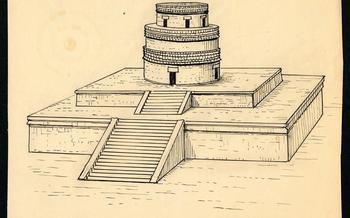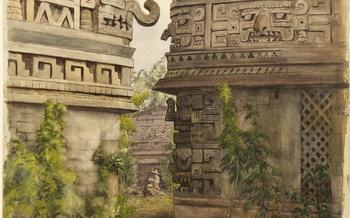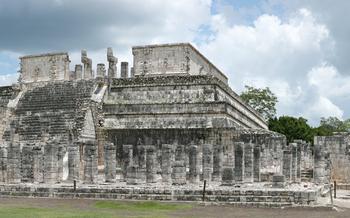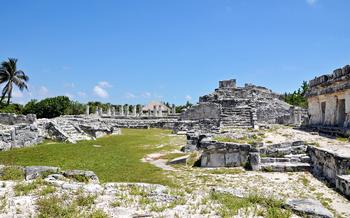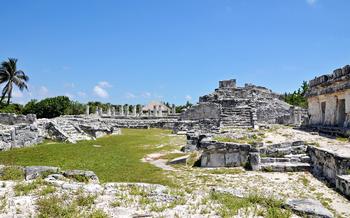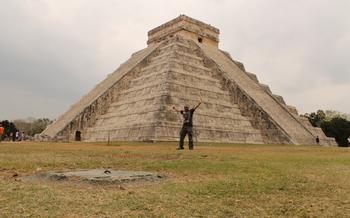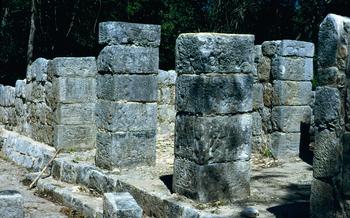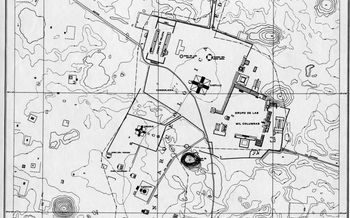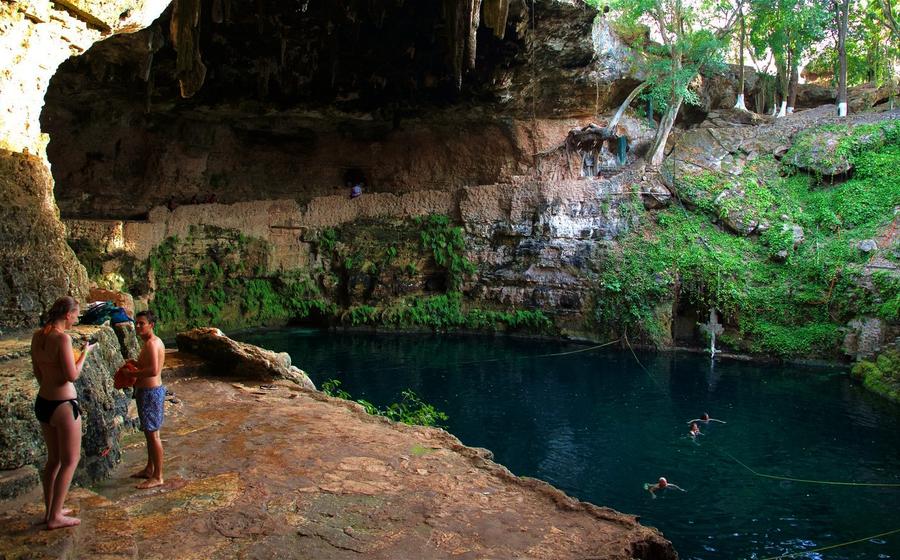
Cenote Zaci
- Chichén Itzá and Cenote Zaci: A Journey Through History and Nature
- Legacy: Architectural Marvels and Their Symbolic Importance
- Unveiling the Cenote Zaci: A Sacred Natural Wonder
- Unique Natural Wonder Within Chichén Itzá
- Unveiling the Cenote Zaci: A Mystical Oasis Within Chichén Itzá
- Planning Your Visit
- Exploring the Archeological Zone
- Unveiling the Pyramid of Kukulcán:
- Discovering the Sacred Cenote
- Ancient Ball Game at Chichén Itzá
- Exploring the Temple of the Warriors
- Unveiling El Caracol Observatory
- Uncovering the Great Platform
- Exploring the Cenote Xtoloc:
- Unveiling the Temple of the Skulls: An Enigmatic Realm of Bones
Chichén Itzá and Cenote Zaci: A Journey Through History and Nature
Legacy: Architectural Marvels and Their Symbolic Importance
Chichén Itzá, a UNESCO World Heritage Site, stands as a testament to the ingenuity and architectural prowess of the ancient Mayans. Its meticulously constructed structures, adorned with intricate carvings and hieroglyphs, embody a profound symbolic and religious significance. The iconic Pyramid of Kukulcán, also known as El Castillo, dominates the skyline, showcasing the Mayan obsession with astronomy and the calendar. The ball court, the largest in Mesoamerica, played a crucial role in the Mayan ball game, which was deeply intertwined with religious rituals and ceremonies. The Temple of the Warriors, with its imposing presence and elaborate sculptures, offers a glimpse into the military prowess and grandeur of the Maya civilization.
Unveiling the Cenote Zaci: A Sacred Natural Wonder
Unique Natural Wonder Within Chichén Itzá
Cenote Zaci, nestled within the heart of Chichén Itzá, is a mesmerizing natural wonder that adds to the site's allure. This sinkhole, formed by the collapse of limestone bedrock, reveals a crystalline pool of fresh water, surrounded by lush vegetation. The cenote's depth reaches an impressive 15 meters, providing a refreshing respite from the tropical heat and an opportunity to connect with the refreshing waters of the Mayan underworld. Its crystal-clear waters invite visitors to dive in and explore the underwater world, home to a diverse array of aquatic life and captivating rock formations.
Unveiling the Cenote Zaci: A Mystical Oasis Within Chichén Itzá
Nestled within the heart of Chichén Itzá, the sacred Cenote Zaci unveils a unique natural wonder. This subterranean marvel, with its crystal-clear waters and mystical aura, holds a profound significance for the ancient Mayans. Formed by the collapse of a limestone bedrock, the cenote served as a vital source of water and a sacred site for religious rituals.
Geological Formation and Mystical Significance: The Cenote Zaci's geological formation is a testament to the power of nature. Over millions of years, rainwater seeped through the porous limestone, creating an intricate network of underground chambers and tunnels. The collapse of these chambers resulted in the formation of the cenote, revealing a breathtaking natural pool.
For the ancient Mayans, cenotes were considered sacred portals to the underworld. They believed that these natural wells connected the world of the living with the realm of the gods and ancestors. Cenote Zaci held particular importance as a place of pilgrimage, where Mayans performed rituals, offerings, and ceremonies to honor their deities and seek divine guidance.
Crystal-Clear Waters and Refreshing Swimming Experience: Immerse yourself in the crystal-clear waters of Cenote Zaci and experience a refreshing dip in its cool depths. The cenote's water, filtered naturally through the limestone rock, offers a unique clarity, allowing you to gaze into its depths and admire the diverse aquatic life that thrives within.
Swimming in Cenote Zaci is a revitalizing experience, providing a welcome respite from the tropical heat of Yucatán. Whether you choose to swim leisurely or dive into the cenote's depths, the refreshing waters will rejuvenate your body and soul, leaving you feeling refreshed and invigorated.
Cultural Importance and Ancient Rituals: Cenote Zaci played a crucial role in Mayan culture and religious practices. Mayans believed that cenotes were gateways to the underworld, where the spirits of the deceased resided. They performed elaborate rituals and ceremonies at the cenote, seeking guidance from the gods and ancestors.
Archaeological excavations have revealed numerous artifacts and offerings within the cenote, including jade, ceramic vessels, and precious jewelry. These offerings were believed to appease the gods and ensure their favor. The cenote's sacred status also made it a place for pilgrimages and spiritual purification rituals.
Planning Your Visit
Before embarking on your journey to Chichén Itzá, meticulous planning is essential to ensure a comfortable and fulfilling experience.
The optimal time to visit is during the shoulder seasons, between November and April, when the weather is pleasant and the crowds are manageable. During this period, you'll encounter fewer tourists, making it easier to explore the site at your own pace and capture stunning photographs without throngs of people in the background.
To make your trip hassle-free, consider booking a guided tour. These tours typically provide transportation to and from your hotel, knowledgeable guides who can share insights into the site's history and culture, and assistance with navigating the often-crowded areas.
Chichén Itzá is easily accessible by car or bus from major cities in the Yucatán Peninsula. Once you arrive at the site, there's ample parking available for a small fee. The site is well-equipped with facilities such as restrooms, a museum, and a food court, ensuring a comfortable visit for all.
To fully appreciate the grandeur of Chichén Itzá, plan to spend at least half a day exploring the site. However, if you're particularly interested in Mayan history and culture, consider devoting a full day to immerse yourself in the wonders of this ancient city.
Exploring the Archeological Zone
Venturing beyond the iconic Pyramid of Kukulcán, Chichén Itzá's archaeological zone unveils a treasure trove of ancient structures, each holding profound historical and cultural significance. Discover the ball court, a testament to the Mayans' sporting prowess and ritualistic traditions. Admire the intricate details and symbolic carvings adorning the Temple of the Warriors, a masterpiece of Mayan architecture and a testament to their prowess in warfare and conquest. Step into El Caracol, an astronomical marvel that reflects the Mayans' advanced knowledge of celestial movements and their deep connection to the cosmos. Let the acoustics of El Caracol transport you back in time, echoing the whispers of ancient astronomers as they unraveled the mysteries of the night sky.
Unveiling the Pyramid of Kukulcán:
The Pyramid of Kukulcán, also known as El Castillo, stands as the centerpiece of Chichén Itzá, a testament to the ingenuity and architectural prowess of the ancient Mayans. Towering over the site, this iconic structure embodies the profound connection between the Mayans and their celestial beliefs.
Constructed in the 10th century, the pyramid aligns perfectly with the cardinal directions, showcasing the Mayans' advanced astronomical knowledge. Its four sides feature 91 steps, totaling 365 steps in total, symbolizing the days of the solar year. The pyramid's design also incorporates intricate carvings and sculptures, depicting feathered serpents, rain gods, and other significant figures from Mayan mythology.
During the spring and autumn equinoxes, a remarkable light and shadow show occurs at the pyramid. As the sun rises and sets, the corner of the pyramid aligns with the serpent heads carved at its base, casting a shadow that resembles a snake descending the pyramid's staircase. This phenomenon attracts visitors worldwide who marvel at the architectural brilliance and spiritual significance of this ancient masterpiece.
Visitors can climb the pyramid's steps, although the ascent is relatively steep and strenuous. However, the effort is rewarded with breathtaking panoramic views of the surrounding jungle, the Great Ball Court, and the Sacred Cenote. The pyramid's summit offers a unique perspective on the vastness and grandeur of Chichén Itzá, leaving visitors with an unforgettable memory of this ancient city.
Discovering the Sacred Cenote
The Sacred Cenote holds a profound significance in Mayan history and mythology. As a vital water source, it was considered a gateway to the underworld and a place of communication with the gods. Mayans performed sacred rituals and offerings at the cenote, seeking divine guidance and favor. Myths and legends surround the cenote, including the belief that it was used for human sacrifices, particularly young women, to appease the rain god Chaac.
Dive into the crystal-clear waters of the cenote for a refreshing swim, surrounded by the awe-inspiring natural beauty of the site. The cenote's unique geological formation creates a magical atmosphere, with sunlight filtering through the lush vegetation and reflecting off the water's surface. Admire the diverse aquatic life that thrives in the cenote, including colorful fish, turtles, and other fascinating creatures. Explore the underwater formations, such as stalactites and stalagmites, that add to the cenote's enchanting allure.
Ancient Ball Game at Chichén Itzá
The ancient ball game, known as Pok-ta-Pok, was a significant cultural and ritualistic practice among the Mayans. In Chichén Itzá, the ball court is one of the largest and most impressive structures, showcasing the importance of the game.
-
Rules and Significance: The game was played by two teams, using a solid rubber ball. The objective was to keep the ball in motion by hitting it with hips, elbows, or knees, preventing it from touching the ground. The game held symbolic and religious significance, believed to represent the cosmic struggle between light and darkness.
-
Ball Court's Symbolism: The ball court's design and orientation were carefully planned. The sloping walls and inclined playing surface allowed the ball to bounce unpredictably, adding to the game's difficulty. The stone rings embedded in the walls, through which the ball had to pass, symbolized the celestial journey of the sun.
-
Acoustics and Rituals: The ball court's acoustics played a vital role in the game. The sloping walls and stone rings created a reverberating effect, amplifying the sound of the ball's impact. These sounds were believed to represent the voices of the gods, guiding the players and influencing the outcome of the game.
-
Witnessing the Game: Visitors can witness a demonstration of the ancient ball game at Chichén Itzá. Local guides or tour groups often organize symbolic matches, allowing tourists to experience the game's dynamics and cultural significance. Participating in or watching a symbolic game offers a unique glimpse into Mayan history and traditions.
Exploring the Temple of the Warriors
Amidst the grandeur of Chichén Itzá, the Temple of the Warriors stands tall as a testament to the architectural prowess and cultural significance of the ancient Mayans. Built in the 13th century, this majestic temple is an architectural masterpiece adorned with intricate carvings, sculptures, and hieroglyphs that narrate stories of bravery, power, and the divine.
Discover the history and significance of this temple, intricately entwined with the rise and fall of the Mayan empire. Uncover the stories behind the intricate carvings that adorn its walls, depicting epic battles, religious ceremonies, and mythological scenes. Admire the finely preserved sculptures that stand guard, each one a symbol of strength and protection.
Climb the temple's steps and reach the top to witness breathtaking views of the surrounding landscape. Let your gaze wander across the ancient city, imagining the bustling streets and vibrant rituals that once took place here. Feel the energy of the past as you stand in the presence of this enduring monument.
Explore the architectural symbolism and astronomical alignments that imbue the Temple of the Warriors with a sense of mystery and wonder. Discover how the Mayans ingeniously aligned the temple with celestial events, demonstrating their profound knowledge of astronomy and their connection to the cosmos.
Immerse yourself in the grandeur of this sacred space, where warriors were once honored and where the echoes of ancient ceremonies still linger. Let the Temple of the Warriors transport you back in time and awaken your imagination as you delve into the captivating legacy of the Mayan civilization.
Unveiling El Caracol Observatory
El Caracol, also known as the Observatory, stands as a testament to the advanced astronomical knowledge possessed by the ancient Mayans. This unique, snail-shaped structure served as an astronomical observatory, enabling the Mayans to track the movements of celestial bodies and predict astronomical events with remarkable accuracy.
Explore the intricate design of El Caracol, featuring a circular platform surrounded by concentric rings of columns and windows. Each window aligns with specific celestial events, allowing the Mayans to observe and measure the positions of the sun, moon, and stars.
Witness the alignment of the building with celestial events, such as the solstices and equinoxes. During these times, sunlight illuminates specific markers within the structure, providing precise astronomical readings.
Experience the acoustics of El Caracol, which are said to amplify sounds and whispers. Stand at the center of the building and listen to the echoes of your voice, creating a mystical and awe-inspiring atmosphere.
Uncovering the Great Platform
Amidst the sprawling expanse of Chichén Itzá lies the Great Platform, an architectural marvel that stands testament to the ingenuity and grandeur of the ancient Maya. This massive platform, also known as the Great Plaza, served as the central gathering place for the city's inhabitants and was the stage for important ceremonies and events.
As you approach the Great Platform, its sheer size is awe-inspiring. The platform measures an astonishing 200 meters in length and 300 meters in width, covering an area of over 60,000 square meters. Its imposing height adds to its majesty, rising several meters above the surrounding terrain.
The Great Platform is not merely a vast expanse of stone but a complex architectural wonder. It features a series of terraces, ramps, and staircases that create a sense of depth and hierarchy. The platform's surface is adorned with intricate carvings and sculptures, depicting various deities, mythical creatures, and scenes from Mayan life. These intricate embellishments provide a glimpse into the rich symbolism and iconography of the ancient Maya.
Upon reaching the summit of the Great Platform, visitors are rewarded with breathtaking panoramic views of the entire archaeological zone. From this vantage point, one can appreciate the sheer scale and grandeur of Chichén Itzá, with its iconic structures, such as the Pyramid of Kukulcán, the Temple of the Warriors, and El Caracol, rising majestically against the backdrop of the Yucatán jungle.
The Great Platform is not just a historical relic but also a testament to the Maya's advanced understanding of engineering and construction. The platform's design and construction techniques allowed it to withstand the test of time, remaining largely intact despite centuries of exposure to the elements and natural disasters.
Exploring the Great Platform is an unforgettable experience that offers a deeper appreciation for the architectural prowess and cultural significance of Chichén Itzá. As you wander through its ancient corridors and admire its intricate carvings, you cannot help but feel a sense of awe and wonder at the legacy left behind by this remarkable civilization.
Exploring the Cenote Xtoloc:
Beyond the bustling crowds of Chichén Itzá, nestled amidst the lush vegetation, lies another hidden gem—the Cenote Xtoloc. While less renowned than its counterpart, Cenote Zaci, Cenote Xtoloc offers a unique and enchanting experience for those seeking tranquility and natural beauty.
This picturesque cenote, with its crystal-clear waters and stunning rock formations, invites visitors to immerse themselves in its refreshing depths. Dive into the cool waters and explore the underwater world teeming with diverse aquatic life, including colorful fish and turtles. Marvel at the intricate stalactites and stalagmites that adorn the cenote's walls, creating a mesmerizing spectacle of nature's artistry.
Cenote Xtoloc holds a special significance in Mayan culture. It was believed to be a sacred site where ancient Mayans performed rituals and ceremonies. As you swim through its waters, feel the mystical energy that permeates the air, connecting you to the spiritual traditions of the past.
Whether you seek a serene escape from the crowds or an opportunity to connect with nature and history, Cenote Xtoloc is a hidden gem that should not be missed. Discover its tranquil beauty and immerse yourself in the magic of this ancient Mayan cenote.
Unveiling the Temple of the Skulls: An Enigmatic Realm of Bones
Within the confines of Chichén Itzá, shrouded in mystery and intrigue, lies the Temple of the Skulls. This haunting edifice stands as a testament to the Mayans' complex belief system and their preoccupation with the afterlife. Intricate carvings adorn the temple's walls, depicting skulls and bones in various forms, creating an eerie and otherworldly atmosphere.
The Temple of the Skulls was not merely a place of worship but also a site for sacred rituals and ceremonies. Ancient Mayans believed that death was a natural part of the life cycle, and they revered the memory of their ancestors. Within the temple, they performed rituals to honor the dead and seek their guidance and protection.
As you explore the temple, pay close attention to the symbolic motifs and carvings. Each skull and bone holds a deeper meaning, representing different aspects of the Mayan cosmology and their beliefs about the underworld. Discover the significance of the tzompantli, a rack where human skulls were displayed as trophies, and learn about the rituals associated with this practice.
Unraveling the mysteries of the Temple of the Skulls offers a glimpse into the spiritual world of the ancient Mayans. As you wander through its chambers and admire its intricate carvings, let your imagination transport you back in time to witness the sacred ceremonies and rituals that once took place within these walls.
